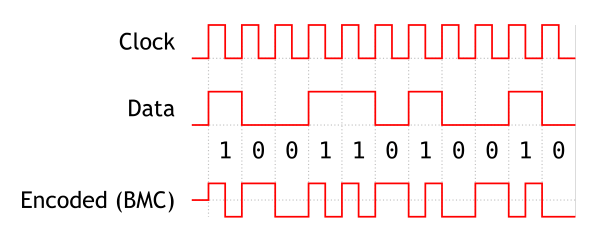Delay encoding
In telecommunications, delay encoding is the encoding of binary data to form a two-level signal where (a) a "0" causes no change of signal level unless it is followed by another "0" in which case a transition to the other level takes place at the end of the first bit period; and (b) a "1" causes a transition from one level to the other in the middle of the bit period.
Delay encoding is used primarily for encoding radio signals because the frequency spectrum of the encoded signal contains less low-frequency energy than a conventional non-return-to-zero (NRZ) signal and less high-frequency energy than a biphase signal.
Delay encoding is an encoding using only half the bandwidth for biphase encoding but features all the advantages of biphase encoding: To be rewritten: It is guaranteed to have transitions every other bit, meaning that decoding systems can adjust their clock/DC threshold continuously. One drawback is human readability (e.g. on an oscilloscope).
Delay encoding is also known as Miller encoding (named after Armin Miller, its inventor). <US Pat. # 3,108,261>
Some RFID cards, in particular EPC UHF Gen 2 RF cards, use a variant called "Miller sub-carrier coding".[1] In this system, 2, 4 or 8 cycles of a subcarrier square wave are transmitted for each bit time. The Miller encoding transitions are indicated by 180° phase shifts in the subcarrier, i.e. the subcarrier pauses for 1/2 of a cycle at each transition. (The resultant binary subcarrier is itself either ASK or PSK modulated on another carrier.)
References
- ↑ UHF Gen 2 System Overview, p. 19. (March, 2005) Archived August 26, 2011, at the Wayback Machine.
![]() This article incorporates public domain material from the General Services Administration document "Federal Standard 1037C".
This article incorporates public domain material from the General Services Administration document "Federal Standard 1037C".
